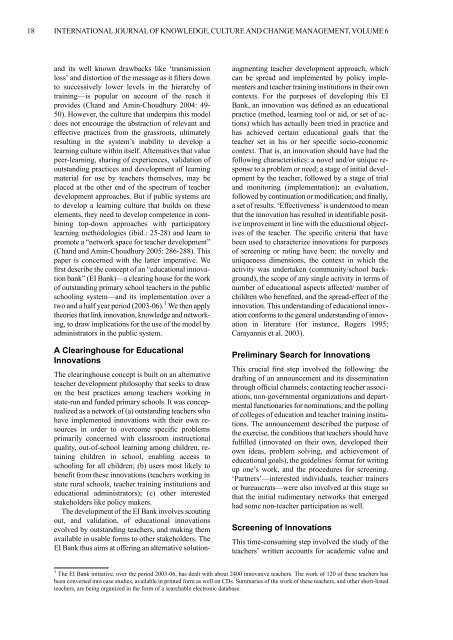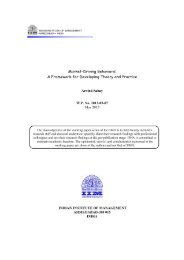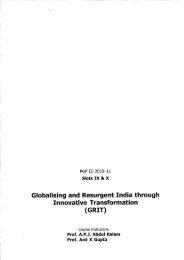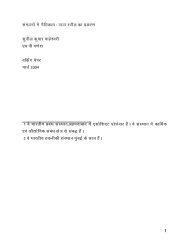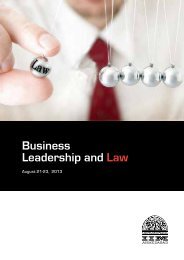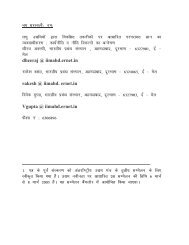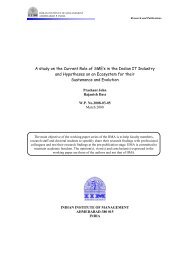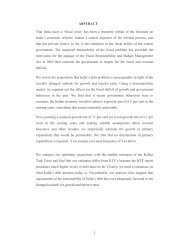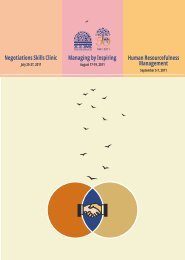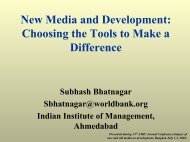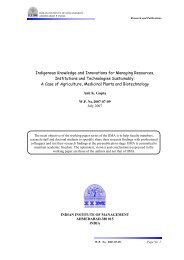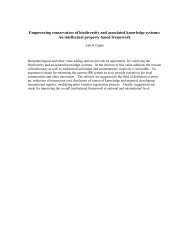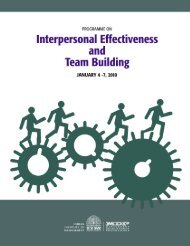related paper - Indian Institute of Management, Ahmedabad
related paper - Indian Institute of Management, Ahmedabad
related paper - Indian Institute of Management, Ahmedabad
Create successful ePaper yourself
Turn your PDF publications into a flip-book with our unique Google optimized e-Paper software.
18<br />
INTERNATIONAL JOURNAL OF KNOWLEDGE, CULTURE AND CHANGE MANAGEMENT, VOLUME 6<br />
and its well known drawbacks like ‘transmission<br />
loss’ and distortion <strong>of</strong> the message as it filters down<br />
to successively lower levels in the hierarchy <strong>of</strong><br />
training—is popular on account <strong>of</strong> the reach it<br />
provides (Chand and Amin-Choudhury 2004: 49-<br />
50). However, the culture that underpins this model<br />
does not encourage the abstraction <strong>of</strong> relevant and<br />
effective practices from the grassroots, ultimately<br />
resulting in the system’s inability to develop a<br />
learning culture within itself. Alternatives that value<br />
peer-learning, sharing <strong>of</strong> experiences, validation <strong>of</strong><br />
outstanding practices and development <strong>of</strong> learning<br />
material for use by teachers themselves, may be<br />
placed at the other end <strong>of</strong> the spectrum <strong>of</strong> teacher<br />
development approaches. But if public systems are<br />
to develop a learning culture that builds on these<br />
elements, they need to develop competence in combining<br />
top-down approaches with participatory<br />
learning methodologies (ibid.: 25-28) and learn to<br />
promote a “network space for teacher development”<br />
(Chand and Amin-Choudhury 2005: 286-288). This<br />
<strong>paper</strong> is concerned with the latter imperative. We<br />
first describe the concept <strong>of</strong> an “educational innovation<br />
bank” (EI Bank)—a clearing house for the work<br />
<strong>of</strong> outstanding primary school teachers in the public<br />
schooling system—and its implementation over a<br />
two and a half year period (2003-06). 1 We then apply<br />
theories that link innovation, knowledge and networking,<br />
to draw implications for the use <strong>of</strong> the model by<br />
administrators in the public system.<br />
A Clearinghouse for Educational<br />
Innovations<br />
The clearinghouse concept is built on an alternative<br />
teacher development philosophy that seeks to draw<br />
on the best practices among teachers working in<br />
state-run and funded primary schools. It was conceptualized<br />
as a network <strong>of</strong> (a) outstanding teachers who<br />
have implemented innovations with their own resources<br />
in order to overcome specific problems<br />
primarily concerned with classroom instructional<br />
quality, out-<strong>of</strong>-school learning among children, retaining<br />
children in school, enabling access to<br />
schooling for all children; (b) users most likely to<br />
benefit from these innovations (teachers working in<br />
state rural schools, teacher training institutions and<br />
educational administrators); (c) other interested<br />
stakeholders like policy makers.<br />
The development <strong>of</strong> the EI Bank involves scouting<br />
out, and validation, <strong>of</strong> educational innovations<br />
evolved by outstanding teachers, and making them<br />
available in usable forms to other stakeholders. The<br />
EI Bank thus aims at <strong>of</strong>fering an alternative solutionaugmenting<br />
teacher development approach, which<br />
can be spread and implemented by policy implementers<br />
and teacher training institutions in their own<br />
contexts. For the purposes <strong>of</strong> developing this EI<br />
Bank, an innovation was defined as an educational<br />
practice (method, learning tool or aid, or set <strong>of</strong> actions)<br />
which has actually been tried in practice and<br />
has achieved certain educational goals that the<br />
teacher set in his or her specific socio-economic<br />
context. That is, an innovation should have had the<br />
following characteristics: a novel and/or unique response<br />
to a problem or need; a stage <strong>of</strong> initial development<br />
by the teacher, followed by a stage <strong>of</strong> trial<br />
and monitoring (implementation); an evaluation,<br />
followed by continuation or modification; and finally,<br />
a set <strong>of</strong> results. ‘Effectiveness’ is understood to mean<br />
that the innovation has resulted in identifiable positive<br />
improvement in line with the educational objectives<br />
<strong>of</strong> the teacher. The specific criteria that have<br />
been used to characterize innovations for purposes<br />
<strong>of</strong> screening or rating have been: the novelty and<br />
uniqueness dimensions, the context in which the<br />
activity was undertaken (community/school background),<br />
the scope <strong>of</strong> any single activity in terms <strong>of</strong><br />
number <strong>of</strong> educational aspects affected/ number <strong>of</strong><br />
children who benefited, and the spread-effect <strong>of</strong> the<br />
innovation. This understanding <strong>of</strong> educational innovation<br />
conforms to the general understanding <strong>of</strong> innovation<br />
in literature (for instance, Rogers 1995;<br />
Carayannis et al. 2003).<br />
Preliminary Search for Innovations<br />
This crucial first step involved the following: the<br />
drafting <strong>of</strong> an announcement and its dissemination<br />
through <strong>of</strong>ficial channels; contacting teacher associations,<br />
non-governmental organizations and departmental<br />
functionaries for nominations; and the polling<br />
<strong>of</strong> colleges <strong>of</strong> education and teacher training institutions.<br />
The announcement described the purpose <strong>of</strong><br />
the exercise, the conditions that teachers should have<br />
fulfilled (innovated on their own, developed their<br />
own ideas, problem solving, and achievement <strong>of</strong><br />
educational goals), the guidelines/ format for writing<br />
up one’s work, and the procedures for screening.<br />
‘Partners’—interested individuals, teacher trainers<br />
or bureaucrats—were also involved at this stage so<br />
that the initial rudimentary networks that emerged<br />
had some non-teacher participation as well.<br />
Screening <strong>of</strong> Innovations<br />
This time-consuming step involved the study <strong>of</strong> the<br />
teachers’ written accounts for academic value and<br />
1 The EI Bank initiative, over the period 2003-06, has dealt with about 2400 innovative teachers. The work <strong>of</strong> 120 <strong>of</strong> these teachers has<br />
been converted into case studies, available in printed form as well on CDs. Summaries <strong>of</strong> the work <strong>of</strong> these teachers, and other short-listed<br />
teachers, are being organized in the form <strong>of</strong> a searchable electronic database.


